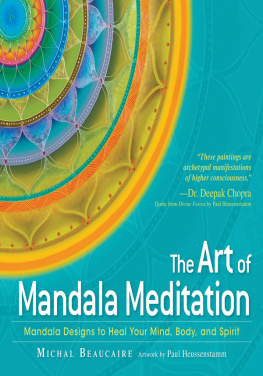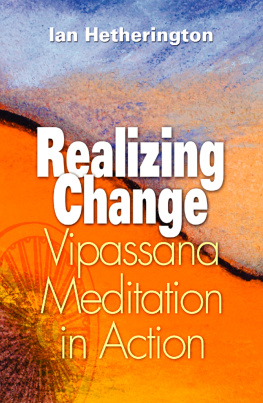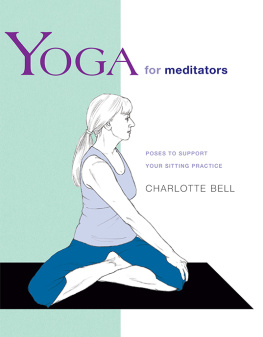Inward
Fieldwork Encounters and Discoveries
A series edited by Robert Emerson and Jack Katz
Inward
Vipassana Meditation and the Embodiment of the Self
Michal Pagis
The University of Chicago Press
Chicago and London
The University of Chicago Press, Chicago 60637
The University of Chicago Press, Ltd., London
2019 by The University of Chicago
All rights reserved. No part of this book may be used or reproduced in any manner whatsoever without written permission, except in the case of brief quotations in critical articles and reviews. For more information, contact the University of Chicago Press, 1427 E. 60th St., Chicago, IL 60637.
Published 2019
Printed in the United States of America
28 27 26 25 24 23 22 21 20 19 1 2 3 4 5
ISBN-13: 978-0-226-63938-3 (cloth)
ISBN-13: 978-0-226-36187-1 (paper)
ISBN-13: 978-0-226-63941-3 (e-book)
DOI: https://doi.org/10.7208/chicago/9780226639413.001.0001
Library of Congress Cataloging-in-Publication Data
Names: Pagis, Michal, author.
Title: Inward : vipassana meditation and the embodiment of the self / Michal Pagis.
Other titles: Fieldwork encounters and discoveries.
Description: Chicago : The University of Chicago Press, 2019. | Series: Fieldwork encounters and discoveries
Identifiers: LCCN 2018055501 | ISBN 9780226639383 (cloth : alk. paper) | ISBN 9780226361871 (pbk. : alk. paper) | ISBN 9780226639413 (e-book)
Subjects: LCSH: Vipasyana (Buddhism) | MeditationBuddhismSocial aspects. | Mind and body. | Self.
Classification: LCC BQ5630.V5 P325 2019 | DDC 294.3/4435dc23
LC record available at https://lccn.loc.gov/2018055501

This paper meets the requirements of ANSI / NISO Z39.48-1992 (Permanence of Paper).
Contents
My debt of thanks runs wide and deep. First and foremost, I would like to express my gratitude to the many participants in this study, who welcomed me into their homes and their hearts. No less, I wish to thank the teachers and volunteers at the Vipassana Meditation Foundation in Israel, Illinois, and Massachusetts, whose hospitality and loving-kindness extended not only to their students but also to this researcher.
My scholarly community has long been my emotional and intellectual refuge. The focused attention of Andrew Abbott, Andreas Glaeser, John Lucy, Steven Collins, Erika Summers-Effler, and Jack Katz contributed immeasurably to this project. Specifically, Andreas Glaeser prompted me to pursue this line of research and modeled what it is to be a teacher, a scholar, and a person; Andrew Abbotts endless flow of fresh ideas showed me what creativity and independent thinking are all about; and Jack Katzs invaluable comments on this manuscript helped me to hone my argument and contribution. Wendy Cadge, Stephan Bargheer, Iddo Tavory, Karin Nisenbaum, and Naama Kopelman all offered sage advice at different phases of this project.
My colleagues in the sociology department at Bar Ilan University in Israel were my support network while writing. Financial support from the Schnitzer Foundation at Bar-Ilan University helped with the last stages toward publication. A special thanks to Sara Tropper, who copyedited the manuscript, for her fine editorial flair.
My final and most profound thanks go to my family. Without my parents, Rina and Alex Pagis, my sisters, Dalit and Ifat, my beloved son, Aranwho has never known life without this projectand most of all my husband, Udi, this book would never have been written. I am forever grateful for their love.
A number of Buddhist words appear in the book, all introduced in Pali, the scriptural language of Theravada Buddhism from which vipassana meditation originated. Vipassan, the most used Pali word in the text, is pronounced by teachers and practitioners as vih-pah-san-ah. Other Pali words include nibbna, samdhi, satipahna, npna, sutta, dhamma, dukkha, anatta, and mett. Many of these words are spelled with diacritical marks, as above; however, for ease of reading I have omitted those marks. I use the Pali terms and not the Sanskrit ones, as these are the terms used in the vipassana retreats I studied (e.g., nibbana and not nirvana, dhamma and not dharma, sutta and not sutra).
Turning Inward
Interiority has come into its own. More and more people are looking inward, toward their minds and bodies. This gaze is oriented through different channels and practices, many of which are based on religious or spiritual traditions. Inward is about one such practice: vipassana, a Buddhist meditation of mindfulness that involves a nonjudgmental or detached observation of the body and mind.
The practice of vipassana and the microsociological world that surrounds it form the core of this book. Yet the reader will be taken far beyond vipassana itself. In my inquiry, vipassana is used as a window onto the complex relations between bodies, selves, and social worlds. Through examining the phenomenological reality of vipassana practitioners, their silent interactions in meditation centers, their heightened sensitivity to the body, and their attempts to transform themselves and their social lives by monitoring bodily sensations, I supply a sociological framework for the study of the place of embodied awareness in processes of self-making. Such a framework enhances our understanding of the connection between inner self-relations and self-other relations, and of the role of the visceral body in linking the two.
What does it mean to look inward? What do we find when we do so? This is a challenging question, because the notion of inwardness implies an inversion of the usual direction of attention in everyday life. Generally attention is focused on the world in which one acts, that is, the world outside oneself. On a personal level, this world might be the text I am writing, the game I am playing, or the conversation I am having with a friend. In the course of such daily action, I am tacitly aware of different aspects of the embodiment of the selfadjusting my fingers on the keyboard when misspelling a word, feeling a pain in my back and moving in order to relieve it, noticing anger rising up and trying to control my desire to shout. This awareness is kept at the background of action and behavior in the world, as my focused attention is set on interaction with other people and things.
As social beings, we interact in the world with an awareness of how others perceive us. Thus in everyday interaction one diverts attention to ones body, emotion, or behavior in order to adjust to, or influence, others perceptions of us. While such awareness of the embodiment of the self is key for social interaction, it is mostly under wraps, kept at the background of awareness, a base from which one attends to the world. It is the world that is at the focal point of attention, not ones interiority.
The kind of inward looking that this book investigates turns such activity inside out. It puts interiority at the focal point of attention, as a subject of interest in and of itself. Such inward looking may have a goal or vision that is connected to action in the worldone might go to a psychotherapist and speak about ones emotions in order to be a better mother. Or one might practice yoga in order to modulate ones reactions to feeling frustrated or anxious over the course of the day. But the situated practice of looking inward is distinct from daily action and engagement. It entails a diversion of attention away from the world and toward the self. Moreover, when we so divert our attention, we start finding things. I, for example, discover emotions, thoughts, and sensations that are new to me and that are now becoming a part of who I am. My inner sphere expands as a whole world of interiority is revealed.














 This paper meets the requirements of ANSI / NISO Z39.48-1992 (Permanence of Paper).
This paper meets the requirements of ANSI / NISO Z39.48-1992 (Permanence of Paper).